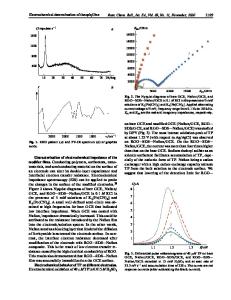A Schiff base modified graphene oxide film for anodic stripping voltammetric determination of arsenite
- PDF / 1,148,224 Bytes
- 9 Pages / 595.276 x 790.866 pts Page_size
- 55 Downloads / 346 Views
ORIGINAL PAPER
A Schiff base modified graphene oxide film for anodic stripping voltammetric determination of arsenite Ranjeet Kaur 1 & Shweta Rana 1 & Raghubir Singh 2 & Varinder Kaur 1
&
Priyanka Narula 1
Received: 20 May 2019 / Accepted: 9 September 2019 # Springer-Verlag GmbH Austria, part of Springer Nature 2019
Abstract A protocol is described for chemical modification of graphene oxide with a Schiff base derived from diethylenetriamine and 2hydroxy-4-methoxybenzophenone. The base was grafted onto an indium tin oxide (ITO) film and applied to electroanalytical determination of arsenite. Successful grafting was confirmed by Fourier transform-infrared spectroscopy, spectrophotometry, field emission scanning electron microscopy and cyclic voltammetry. Secondly, the coated ITO film served as a working electrode for the stripping voltammetric determination of arsenite. The analytical signal is generated by selective oxidation of metal species via multi-donor sites present in the derivatized Schiff base. The electroanalytical protocol was optimized by investigating the effects of deposition time, working potential, frequency and amplitude of square wave anodic stripping voltammetry. The method has attractive features including (a) the usage of a non-metallic, non-toxic and cost-effective material; (b) improved sensitivity (with limit of detection as low as 156 pM) due to better adsorption of arsenite in the Schiff base pockets on the ITO, and (c) the application to the determination of arsenite in real samples. Keywords As(III) . Azomethine . Silatrane . 2-Hydroxybenzophenone . Portable electrodes . Voltammetry . Chronocoulometry . Metallic toxin . Environmental analysis . Oxyanion
Introduction Arsenite (AsIII) has been classified as a “more hazardous” form of arsenic as compared to organoarsenicals (i.e. methylarsonate and dimethylarsinate) and its pentavalent form [1–3]. The increased levels of arsenic species cause numerous endocrine effects in both wildlife and human beings [4]. Therefore, certain analytical methods based upon chromatographic [5], electrochemical [6] and spectrometric techniques [7] have been reported so far for its analysis in environmental samples. In particular, electroanalytical stripping methods are promising for routine analysis due to simple instrumentation,
Electronic supplementary material The online version of this article (https://doi.org/10.1007/s00604-019-3807-9) contains supplementary material, which is available to authorized users. * Varinder Kaur [email protected] 1
Department of Chemistry, Panjab University, Chandigarh 160014, India
2
DAV College, Sector 10, Chandigarh 160 011, India
ease of maneuver, miniaturization, short analysis time, and portability [8]. Especially, square wave anodic stripping voltammetry is highly sensitive electroanalytical technique which is known for consistent excellent results for the quantitative analysis of trace metal ions. It offers various advantages like ability to detect lower concentrations (upto nanomolar to picomolar levels)
Data Loading...











